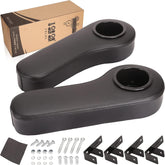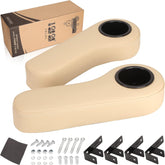The Complete Guide to Golf Cart Tune-Up Kits: Maximizing Performance and Longevity
If you own a golf cart, regular maintenance is essential to ensure optimal performance and longevity. One of the most effective ways to keep your golf cart running smoothly is by using a golf cart tune-up kit. In this comprehensive guide, we will explore the benefits of using a tune-up kit, the components typically included in a kit, and the steps involved in performing a tune-up. Whether you're a DIY enthusiast or prefer to leave it to the professionals, a golf cart tune-up kit is a valuable investment for maintaining your cart's performance.

Benefits of Using a Golf Cart Tune-Up Kit
Regular tune-ups are crucial for keeping your golf cart in top shape. By using a golf cart tune-up kit, you can experience several benefits, including:
-
Improved Performance: A tune-up kit helps identify and address any issues that may be affecting your golf cart's performance. By replacing worn-out parts and addressing maintenance needs, you can restore your cart's power, acceleration, and overall performance.
-
Enhanced Fuel Efficiency: Golf cart tune-up kits often include components that optimize fuel efficiency. By replacing spark plugs, air filters, and fuel filters, you can maximize your cart's fuel consumption and save money in the long run.
-
Extended Lifespan: Regular maintenance and tune-ups can significantly extend the lifespan of your golf cart. By addressing minor issues before they escalate, you can prevent major breakdowns and costly repairs, ensuring your cart serves you well for years to come.
-
Safety Assurance: A well-maintained golf cart is a safe golf cart. By performing regular tune-ups using a kit, you can identify and fix any potential safety hazards, such as faulty brakes, worn-out tires, or malfunctioning lights.
Components of a Golf Cart Tune-Up Kit
While the specific components may vary depending on the brand and model of your golf cart, a typical tune-up kit includes the following:
-
Spark Plugs: Spark plugs play a crucial role in igniting the fuel-air mixture in the engine. Over time, they can become fouled or worn out, leading to decreased performance. Replacing spark plugs regularly helps maintain optimal engine performance.
-
Air Filter: The air filter prevents dirt, dust, and debris from entering the engine, ensuring clean airflow for combustion. A clogged or dirty air filter can restrict airflow, reducing engine efficiency. Regularly replacing the air filter helps maintain proper engine function.
-
Fuel Filter: The fuel filter traps impurities and contaminants present in the fuel, preventing them from reaching the engine. Over time, the filter can become clogged, affecting fuel flow and engine performance. Replacing the fuel filter ensures a clean fuel supply and optimal performance.
-
Oil Filter: The oil filter removes contaminants from the engine oil, ensuring smooth lubrication and preventing premature engine wear. Regularly replacing the oil filter helps maintain clean oil and extends the life of the engine.
-
Belts and Hoses: Tune-up kits may include replacement belts and hoses, as these components can wear out over time. Inspecting and replacing worn or damaged belts and hoses helps prevent breakdowns and ensures proper functioning of various systems in the golf cart.
-
Spark Plug Wires: Spark plug wires deliver electrical current from the ignition system to the spark plugs. Over time, they can become damaged or worn, leading to misfires and engine performance issues. Replacing spark plug wires ensures proper ignition and optimal performance.
-
Other Components: Depending on the specific tune-up kit, it may also include items like a fuel pump, carburetor rebuild kit, or other parts specific to your golf cart model.
Perform a Golf Cart Tune-Up: Step-by-Step Guide
Performing a golf cart tune-up with a kit can be a straightforward process. Here's a general step-by-step guide:
-
Gather the necessary tools: Before starting, make sure you have the required tools, such as wrenches, screwdrivers, and pliers, as well as safety equipment like gloves and safety glasses.
-
Consult the owner's manual: Refer to your golf cart's owner's manual for specific instructions and torque specifications.
-
Disconnect the battery: Safety should always be a priority. Begin by disconnecting the battery to prevent any accidental electrical issues during the tune-up process.
-
Replace spark plugs: Remove the old spark plugs using a spark plug socket and replace them with new ones. Ensure they are properly tightened but avoid overtightening.
-
Inspect and replace filters: Check the air filter, fuel filter, and oil filter. If they are dirty or clogged, replace them according to the manufacturer's instructions.
-
Check belts and hoses: Inspect the belts and hoses for signs of wear or damage. Replace any worn or damaged components to prevent potential failures.
-
Inspect spark plug wires: Check the condition of the spark plug wires. Replace any damaged or worn wires to ensure proper ignition.
-
Reassemble and reconnectthe components: Once you have replaced any necessary parts, reassemble the components in the reverse order of disassembly. Make sure everything is properly secured and connected.
-
Reconnect the battery: Once you have completed the tune-up, reconnect the battery and ensure it is securely connected.
-
Test the golf cart: Start the golf cart and take it for a test drive to ensure everything is functioning properly. Pay attention to any changes in performance or unusual sounds.
Conclusion
Regular tune-ups are essential for maintaining the performance and longevity of your golf cart. Using a golf cart tune-up kit can simplify the process and ensure that you have all the necessary components to address common maintenance needs. By following the steps outlined in this guide, you can keep your golf cart running smoothly and enjoy many more rounds on the course. Remember to consult your golf cart's owner's manual for specific instructions and always prioritize safety during the tune-up process.











Leave a comment
Please note, comments need to be approved before they are published.